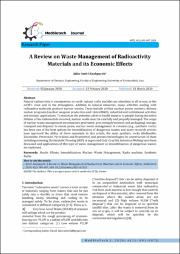A Review on Waste Management of Radioactive Materials and its Economic Effects
(ندگان)پدیدآور
Amiri Koohpayeh, Jafarنوع مدرک
TextResearch Paper
زبان مدرک
Englishچکیده
Abstract Natural radioactivity is omnipresent on earth: natural radio nuclides are abundant in all oceans, in the earth's crust and in the atmosphere. Addition to natural resources, many activities dealing with radioactive materials produce nuclear wastes. These include civilian nuclear power reactors, defense nuclear programs (nuclear weapons production and related R&D), industrial and institutional activities and isotopic applications. To minimize the potential adverse health impacts to people during the entire lifetime of the radionuclide involved, nuclear waste must be carefully and properly managed. The scope of nuclear waste management encompasses generation, processing (treatment and packaging), storage, transport and disposal. In recent years, nuclear waste management in ceramics (e.g., synthetic rocks) has been one of the best options for immobilization of dangerous wastes and many research articles have approved the ability of these materials. In this article, the main synthetic rocks (Hollandite, Zirconolite, Perovskite, Pyrochlore and Brannerite) and process technologies for construction of them including sintering, HotIsostatic Pressing (HIP) in argon and Cold-Crucible Induction Melting have been discussed and applications of this type of waste management on immobilization of dangerous wastes are explained.
کلید واژگان
Health effectsImmobilization
Nuclear Waste Management
Radio nuclides
Synthetic Rocks
شماره نشریه
01تاریخ نشر
2020-03-011398-12-11
ناشر
Iranian-Australian Community of Science http://irausci.irسازمان پدید آورنده
Department of Chemical Engineering, Faculty of Engineering, University of Kermanshah, Iranشاپا
2209-25282209-2536





